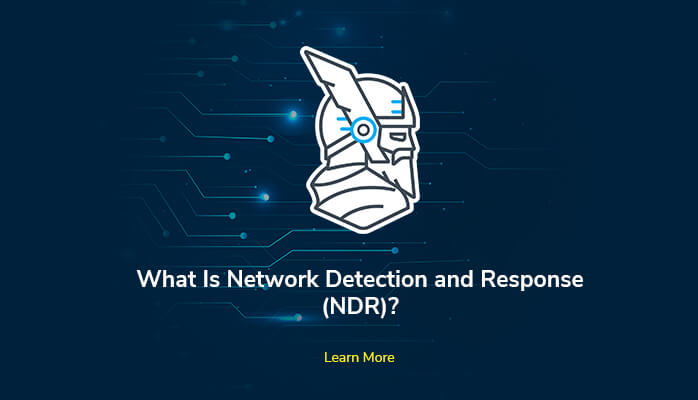In the early 2010s, Network Detection and Response (NDR) technology was developed to detect and neutralize evasive network threats that were difficult to stop using known attack patterns or signatures.
NDR, also known as Network Traffic Analysis (NTA), monitors network traffic and creates a baseline of activity using machine learning and behavioral analysis. They can then identify suspicious activity linked to malware, Domestic abuseand dangerous behavior or targeted attacks.
Using NDR solutions, businesses can detect anomalous traffic that may be related to malware, lateral movement, command and control, or extortion.
How does network detection and response work?
Network Detection and Response (NDR) solutions continuously monitor the company’s network by collecting all network traffic, using behavioral analysis, machine learningand artificial intelligence Identifying cyber threats and abnormal behavior, and taking appropriate measures against these threats, directly or by combining with other cyber security tools.
NDR solutions go beyond mere threat detection; They also enable real-time threat response through native controls or a variety of integrations with other cyber security tools and solutions, such as Security Orchestration, Automation and Response (SOAR).
The most common tools and techniques used by NDR tools are machine learning, heuristics, statistical analysis, signatures and threat intelligence feeds. Here are more details about them:
machine learning
In order to analyze huge data sets and make more accurate predictions, machine learning makes use of computing power. When it comes to NDR solutions, machine learning models can use behavioral analytics to find unknown network threats. Algorithms using machine learning can identify predictable cyber threats and enable faster classification and remediation. In addition, potential threats are continuously re-evaluated using machine learning models based on actual results.
Heuristics
By examining data for suspicious characteristics, heuristic analysis contributes to threat detection. In NDR solutions, heuristics are used to improve the effectiveness of signature-based detection techniques by looking beyond current threats and identifying suspicious features in new as well as modified versions of known threats.
A statistical analysis
Statistical analysis is a useful behavioral technique, which can include anything from simple outlier analysis (such as identifying URLs that have not been visited by a group of devices) to basic Bayesian analyzes of network traffic patterns. Typically, statistical analysis includes a sampling component to establish a baseline that is then used to identify which activity deviates from normal traffic patterns, allowing SOCs to characterize typical network traffic and display unusual suspicious behavior.
Signatures
In order to identify a known threat in the future, signature-based detection techniques use specific indicator of compromise Identifier (IOC). This method has lost much of its effectiveness in a world where attacks like credential replay, custom malware, and malware toolkits are the norm.
Feeds of threat intelligence
Data streams called threat intelligence feeds provide information about previously identified online threats. Threat intelligence can help NDR solutions identify known threats and offer additional contextual information to rank detected network anomalies by risk, if advanced and possible. The need to actively obtain, manage, and collect threat data to ensure information is up-to-date and relevant is a limitation of threat intelligence updates.
NDR benefits
My colleague Andrea has already mentioned some NDR advantages in her article on the subject Network Detection and Response (NDR) vs. Endpoint Detection and Response (EDR): A Comparison:
Newer and more advanced malware (such as polymorphic malware) is more likely to be stopped by the NDR solution.
The ‘Weaponized AI’ used by cybercriminals can be adapted to the AI solution integrated into NDR.
By using the forensics provided by NDR, you can determine how malware broke into the network in the first place and mitigate the problem so that your network is secure in the future.
Incident response and threat hunting processes become faster and more efficient with NDR.
Furthermore, a network detection and response solution:
- tin Expand the visibility of the attack to avoid false negatives; They can literally see every network activity going on, including the late stages of an attack, in addition to lateral movement and disposal operations.
- has Zero footprint on the network When using cloud-delivered analytics. Modern network detection and response tools are delivered through the cloud, which streamlines operations by eliminating the need for IT teams to set up entirely new log servers on site to collect and analyze network data.
Advanced NDR platforms can also collect network logs from network security tools already in use, such as network firewalls, removes the need for dedicated network sensors. With minimal interaction, NDR systems provide complete threat visibility and detection.
NDR disadvantages
Although AI-driven NDR solutions are automated and significantly increase security detection and Security Operations Center (SOC) Efficiency, the NDR tool also has disadvantages:
- They can only monitor and track web logs; They cannot track or monitor endpoint events such as process information, registry changes, or system commands.
- They cannot look at identity or cloud data or other important sources of security information.
- NDR solutions can be expensive to deploy and maintain, can lead to potential blind spots, and can require switching between consoles for security analysts to gather context.
Improve network detection and response with Heimdal®
By providing Heimdal® unique threat hunting and complete visibility across your entire network Threat Prevention Network The solution can help you improve the scope of your company’s network DNS security.
Regardless of the device or the operating system, you will get protection from A to Z: by leverage machine learning On the infrastructure device, the Heimdal® Threat Prevention Network detects and stops attacks that firewalls can’t see, blocks malicious web content, prevents data leak and local traffic filtering in each environment.
Heimdall can also help you deal with the challenge of multiple consoles – our Threat Prevention Network software can also be used in conjunction with other market leading solutions (Threat prevention endpoint, Repair management, Preferred access management, Application control, Ransomware encryption protection and Next generation antivirus) from our portfolio – grouped in our EDR / XDR Services -, provide you with first class Unified endpoint security.

Your perimeter network is vulnerable to sophisticated attacks.
Heimdal® Threat Prevention – Network
is the next-generation network protection and response solution that will keep your systems safe.
- No need to deploy it on your endpoints;
- Protects every point of entry into the organization, including BYODs;
- Stops even hidden threats using AI and your network traffic log;
- DNS, HTTP and full HTTP, HIPS and HIDS protection;
final thoughts
Network detection and response solutions simulate a baseline of what typical network behavior looks like and notify security teams of any abnormal activity that falls outside this range. They also offer response capabilities that can be completed manually Response to the event and threat hunting efforts and process automation, saving IT teams time.
Their contribution to improving the cybersecurity posture of companies is significant, yet their shortcomings can be addressed by combining them with other essential security solutions, to cover a growing attack surface.
If you liked this article, follow us LinkedIn, Twitter, Facebook, YouTube, and Instagram For more news and topics on cyber security.








